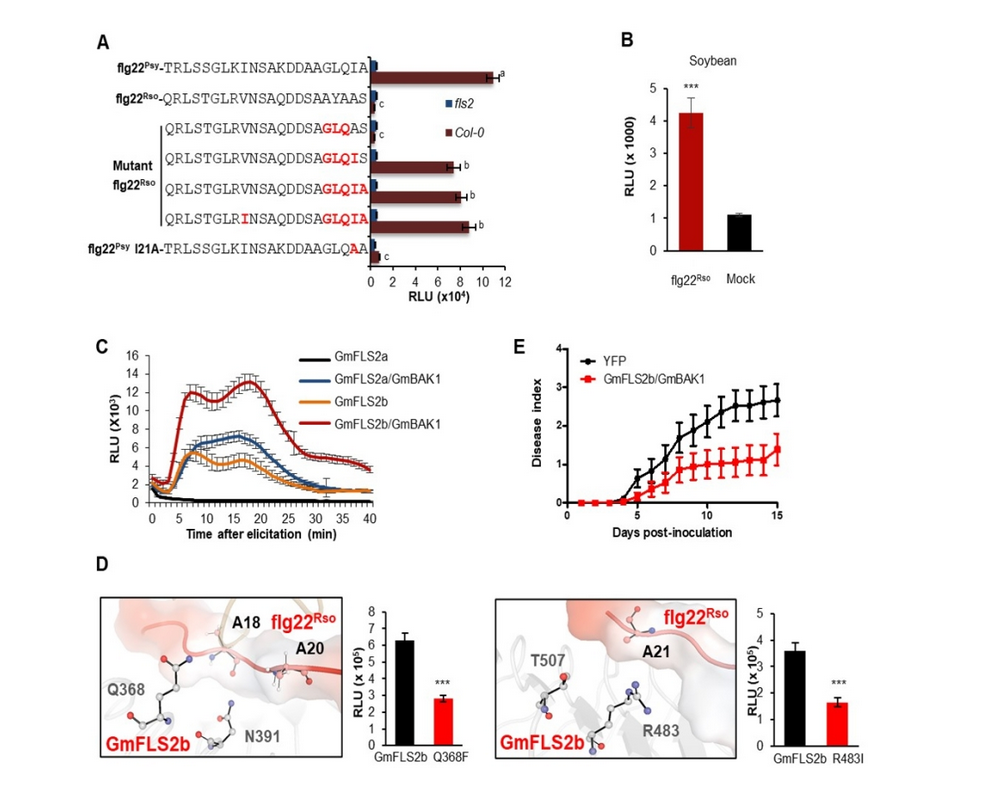New study identifies a plant immune receptor that detects the polymorphic flagellin of Ralstonia solanacearum
Plant diseases caused by bacterial pathogens pose an important threat to food security worldwide. Ralstonia solanacearum is the causal agent of the bacterial wilt disease, which affects important crops such as potato, tomato, tobacco, banana, pepper and eggplant, among others, being responsible for enormous economic losses.
The plant immune system is capable of detecting conserved bacterial molecules, which act as a tell-tale for the presence of invading bacteria. When this happens, immune responses get activated to prevent the development of a disease. The best studied case is that of flagellin, the protein that forms the bacterial flagellum (a structure that many bacteria use as a propeller to move). Although most plants detect flagellin from most bacterial species to activate their immune system, Ralstonia solanacearum evades plant immunity by producing an atypical flagellin protein that cannot be detected by the canonical flagellin receptors.
Recently, a study led by Dr. Alberto Macho at the Shanghai Center for Plant Stress Biology/ CAS Center for Excellence in Molecular Plant Sciences discovered that soybean has exceptionally evolved adapted versions of the flagellin receptors that allow the perception of flagellin from R. solanacearum, revealing a remarkable case of co-evolution between plants and pathogens. This study was framed in the thesis of the PhD student Yali Wei.
Moreover this study employed a combination of homology-based structural modelling, mutagenesis, and immune assays to identify the key polymorphisms that allow R. solanacearum flagellin to avoid perception by typical flagellin receptors. Such analysis allowed the subsequent identification of the key residues in the soybean flagellin receptors that allow the gain of recognition of R. solanacearum flagellin.
Importantly, the expression of the soybean flagellin receptors in roots of tomato, an important crop affected by R. solanacearum, enhanced resistance to bacterial wilt disease. Therefore, this work uncovers the first case of allelic variation that allows recognition of flagellin from R. solanacearum, and the generation of disease resistance induced by this polymorphic flagellin molecule.
This study reveals the mechanism employed by a bacterial flagellin to avoid perception by plant immune receptors, and the plant counter-measure to re-gain perception. Importantly, the direct transfer of the soybean receptors into agronomically important crops affected by bacterial wilt disease, including tomato, potato, among others, could represent a new strategy to enhance resistance to bacterial wilt disease in agricultural systems. Moreover, unravelling the key residues responsible for both evasion and gain of perception paves the way for synthetic biology approaches to customize immune receptors to expand their range of recognition, enabling detection of polymorphic pathogen elicitors.
The study was recently published in Nature Communications, and it has been funded by the Chinese Academy of Sciences and the National Natural Science Foundation of China.

Link to the article: https://www.nature.com/articles/s41467-020-17573-y
Contact:
Prof. Alberto Macho
Email: alberto.macho@psc.ac.cn
Shanghai Center for Plant Stress Biology, CAS/ CAS Center for Excellence in Molecular Plant Sciences